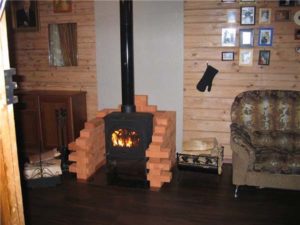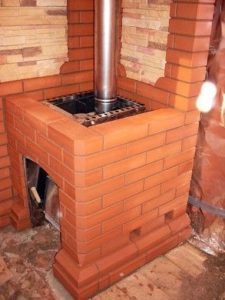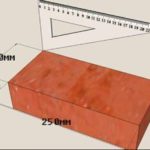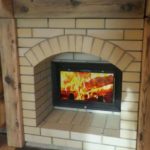Why do iron stoves heat up faster than brick stoves?
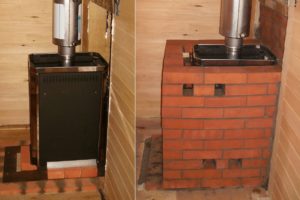 Man is a warm-blooded creature. In winter, he vitally needs heating of living quarters. If your home is not heated, there is a great danger of getting seriously ill and dying. To prevent this from happening, people come up with various heating devices.
Man is a warm-blooded creature. In winter, he vitally needs heating of living quarters. If your home is not heated, there is a great danger of getting seriously ill and dying. To prevent this from happening, people come up with various heating devices.
The content of the article
Distinctive features of furnaces
Heating stoves come in 3 types; all-metal ones are a heating shield and a chimney made of metal, a combined heating shield is made of metal and a chimney is made of brick, stationary ones are completely made of brick.
Comparison based on facts:
- To heat a building, it is necessary to calculate its heated cubic volume.
- A room of up to 30 cubic meters can be heated with an all-metal stove, for example, a potbelly stove.
- Up to 100 cubic meters can be heated with combined stoves. They differ in that they have a metal heating shield and a stationary chimney.
- Over 100 cubic meters it is better to use only a brick oven.
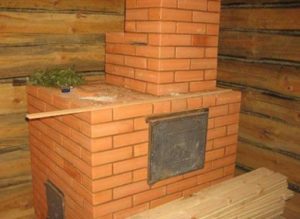
Which stove, brick or iron, will heat the room faster?
This question can only be answered through comparison. Metal, due to its density, is subject to faster heating than brick. The heating rate of the metal varies depending on the design features of the furnace. The thicker the wall, the longer it will take to heat up.
Ceramic products (red brick, refractory) have a porous structure, so they change their own temperature slowly. At the same time, it accumulates heat longer. His returns are higher.
Choosing a device for heating the room. They try to take into account all the nuances. The complexity of installation, size and material used for manufacturing. The main thing that many people take into account first is mobility. It can be moved.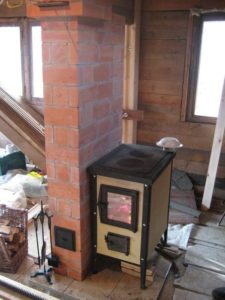
What is the reason for the rapid heating of iron furnaces?
The metal model is less labor-intensive to use. Due to the high density and heat transfer of iron, it can quickly and without hassle heat a small square. True, for the same reason, the stove will cool down very soon, and the room will become much colder. To avoid this, the fire must be constantly maintained in it.
This does not apply to combination models. Due to the brick chimney, it retains heat much longer and is capable of heating large rooms.
The advantages include the mobility of structures:
- They can be installed in any corner of the house, as long as there is a chimney vent.
- The metal model does not have a foundation, like a brick one, so you can move it without much difficulty.
- In addition, it takes up less space in the room.
- For the summer, the stove can be dismantled, the heating panel of either type and put into a closet until it gets colder.
- You can buy it at a hardware store.
- In addition, it will be easier to formalize it in various authorities.
- It will take a minimum of time to obtain the certificate. Because a metal stove is considered a finished unit. At any moment she can be forced to work.
Minuses:
- The disadvantages include increased fire danger.
- Injury is dangerous; you can easily get burned on hot metal.
- Structures made from this material, when exposed to fire, quickly become unusable. Most often, the matter ends with the walls or grates (the place where firewood is laid) burning out.
- On average, such stoves “live” no more than 3-5 years. True, the price for them is not very high.
- Another important detail is that the metal stove does not breathe. Dampness does not leave the surrounding air. This can have a very bad effect on a person’s well-being.
- There is also a high risk of carbon monoxide poisoning. It is released when any fuel is burned, especially gas, wood or coal.
Important! Keep small children and animals away from the oven. This may result in serious injury.
Brick ovens
The peculiarity of a brick stove, unlike a metal one, is that it retains heat longer. This is due not so much to the thickness of the brick as to the characteristics of the chimney.
Through many ventilation ducts, smoke moves to the pipe and heats the wall. This increases the area of the heat-transmitting wall. This increases the efficiency and cubic capacity of the heated room. Due to the fact that the brick has a more porous structure, heating occurs gradually.
Therefore, in order to accumulate heat, this material itself needs to increase its temperature. Due to the air bubbles located in the pores of the baked clay, the heat in the brick lasts for a long time.
The mortar for laying the fixture plays an important role. In addition, this design is able to regulate the humidity in the room. This is done by absorbing moisture into the clay.
Another advantage is the versatility of this type of stove. If, as a rule, you can cook or fry food on a metal one, then in this one you can bake flour products.In addition, the stove on the stationary one is larger, which provides additional space for cooking. This is the best option for keeping warm. After all, such a device heat transfer lasts several hours after the end of the fire.
- The disadvantages are due to the fact that this stove is stationary.
- If necessary, you can’t take it with you on a hike and it won’t fit in the closet.
- For the heat exchange process to normalize, some time must pass, usually 20–25 minutes. After this, the efficiency of the stationary stove increases sharply.
- Another nuisance associated with this type of room heater. After the end of the heating season, the stove sometimes needs to be heated. This is necessary so that the circulation inside the oven does not fail.
- Carbon monoxide and fire safety are the scourge of any stove. If the chimney is installed incorrectly, none of the compared materials will save you.
Attention! After the oven has heated up, it is necessary to close the vent. This is done to reduce draft and blow out heat from the oven.
So which stove holds heat longer, brick or iron?
To summarize, it can be noted that a brick oven retains heat much longer, although it takes longer to heat up
- The efficiency of a metal furnace is up to 80%.
- The efficiency of a brick oven will be up to 75%.
Now it’s clear why it’s better to use a metal stove. As can be seen from the efficiency coefficient, metal is much more efficient at heating a room. True, the features of ceramics are also very good for heating. Perhaps it is better to base this issue on the characteristics of the room itself. The layout will tell you the best option.

